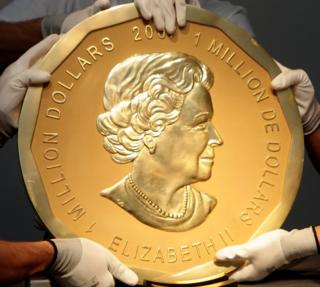 Image copyright
Reuters
Image copyright
Reuters
Four men have gone on trial in Berlin, accused of the notorious theft of a huge solid-gold coin from the German capital's Bode Museum in 2017.
The 100kg (220lb) Canadian "Big Maple Leaf" was made of pure 24-carat gold and was worth €3.75m (£3.4m; $4.3m).
The chief suspects on trial, all in their early 20s, are two brothers and a cousin from a Lebanese Berlin family accused of organised crime links.
A ladder, a wheelbarrow and a getaway car were allegedly used in the heist.
Detectives have not recovered the coin, and believe it has been either cut into pieces or melted down and sold.
Prosecutors allege that the three chief suspects climbed onto adjacent railway tracks and used a ladder as a bridge to break into the museum through a third-floor window, which was not alarmed.
The men then smashed through a bullet-proof glass case to steal the coin. They are believed to have used a wheelbarrow to carry the coin away before abseiling from the tracks to their getaway vehicle.
A fourth man - 20-year-old Denis W - worked as a security guard at the museum and is accused of having facilitated the heist by advising on locations and security.
The men are on trial in a youth court and are not in detention. If found guilty, they could face a custodial sentence.

The Big Maple Leaf coin
- Minted by the Royal Canadian Mint in 2007, and certified at the time by Guinness World Records as the world's largest gold coin
- Five coins were made
- 3cm (1.18in) thick, 53cm in diameter, and with a likeness of Queen Elizabeth II on one side, as Canada's head of state
- The other side shows the Canadian national symbol, the maple leaf
- Canadian Mint says: "Why did the Royal Canadian Mint make the world's purest and largest gold bullion coin? Because we can"
- Was held in a coin cabinet at the Bode Museum as one of more than 540,000 objects, but German media report only the "Big Maple Leaf" was stolen